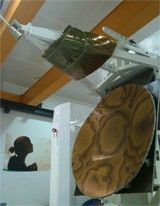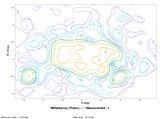
-
StatusCompleted
-
Status date2014-02-27
-
Activity Code5B.012
Thales Alenia Space and its partners have designed, manufactured and tested a 1.3 m reflectarray antenna that produces a dual polarised contoured beam in Ku band.
The main objectives were to benchmark the demonstrator with a reference Ku-Rx Earth Deck contoured beam telecommunication antenna, to demonstrate the capability to achieve large bandwidth, to assess the accuracy of the RF synthesis process, to demonstrate the simplicity of the manufacturing process, and the compatibility of the composite panel with the space environment.
Develop single layer composite panel suitable for space environment. Demonstrate the large bandwidth capability of reflectarray.
Develop a synthesis process with an accuracy compatible with the definition of a contoured beam antenna.
Achieve low cross polarisation radiation with an offset configuration.
The initial motivation was the cost and schedule reductions that are expected due to the simplicity and recurring aspects of the reflectarray concept.
The reflectarray is made of five flat panels arranged along an offset parabolic profile. Faceting the demonstrator is essential for achieving satisfactory RF performances, and especially the largest bandwidth.
A panel assembly has been defined, with low loss materials, very simple and repetitive process, and compatible with the harsh space environment. It is made with a single layer of printed elements, in addition to the ground plane. This facilitates much the thermal management and the industrialization process.
Novel reflectarray elements, referred to as Phoenix elements, have been developed, and have demonstrated their superiority in terms of bandwidth, losses, in addition to their unique characteristic to have a revolving cycle (i.e. with the same starting and ending element). A dense spacing is used : The reflectarray can thus be considered as a periodic reflective surface that is spatially modulated. Major improvements in terms of bandwidth, gain, and reduction of parasitic scattering were demonstrated thanks to this new approach.
An advanced synthesis process was developed with the objective to achieve quasi-zero cross-polarization and similar performance in the two orthogonal polarizations for dual polarized reflectarrays. It includes a preliminary synthesis, also referred to as Phase Only Synthesis (POS), and an Advanced Synthesis accounting for the scattering matrices of the elements. The RF synthesis procedure was extended to the design of low cross polarization reflectarrays. Basically, the elements provide, in addition to the phase shift, a slight depolarization of the incident field so that their cumulative effects can be controlled. Thus, the cross polarization induced by an offset configuration can be compensated for.
The following activities were conducted in phase 1:
- The investigation of missions of interest for reflect-arrays;
- The definition of a single layer reflect-array element meeting RF, mechanical and thermal requirements;
- The selection of materials and processes compatible with RF requirement and with space environment;
- The mechanical and thermal modelling of the reflect-array;
- The development of improved synthesis tools.
Intermediate breadboards were manufactured and tested, for the validation of the concepts and processes.
In Phase 2, a 1.3 m reflect-array demonstrator was then be manufactured and tested.
A 1.3m piecewise reflectarray demonstrator has been designed, manufactured and tested, with a coverage over Canada, US, Puerto Rico and Hawaii. A very good agreement is obtained between the theoretical and measured radiation patterns.
Advanced reflectarray elements, referred to as Phoenix elements, were used, that exhibit a very linear phase variation with frequency between 10 GHz and 14.5 GHz.
The elements are modelled assuming infinite periodicity. This assumption induces modelling errors, that was characterised equivalent to a RMS equal to l/60. This error induces some uncertainties for a shaped coverage, with a 0.2 dB average, and that can locally overpass 1 dB. Means for reducing this RMS modelling error have been identified: Avoid too strong spatial phase variation in the synthesis process, avoid sudden transition between elements, reduce the array lattice.
The cross polarization cancellation process has been developed. Its automatic application to a reflectarray with a very high number of elements requires the development of an algorithm that drives the refinement process of the layout, and that takes advantage of the learning sequence to speed up the process.







